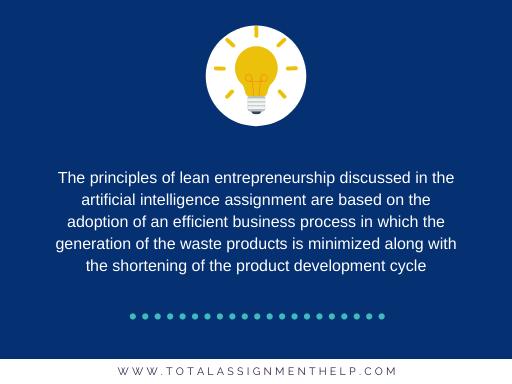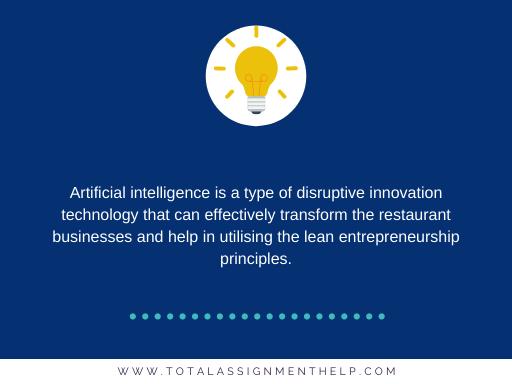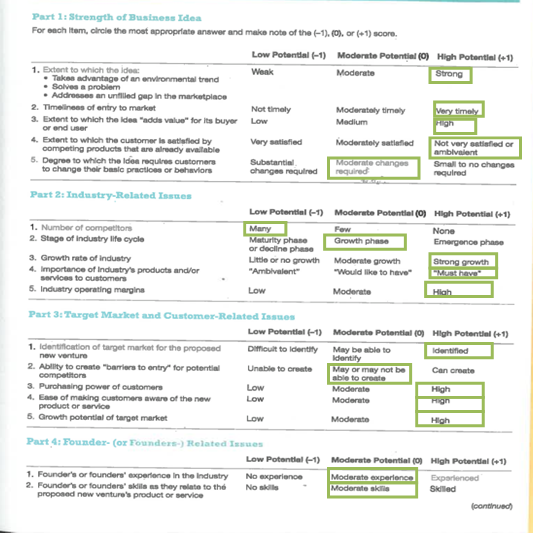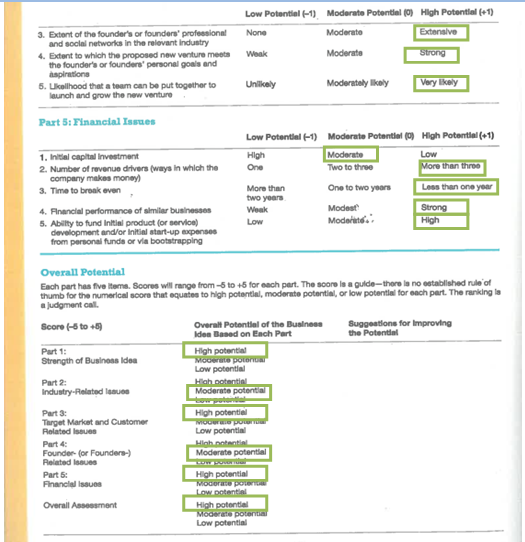Artificial Intelligence Assignment: Business Idea For Restaurant
Question
Task: The objective of this individual assessment submission is to learn how to develop your own business idea, complemented by research and observational insights that detail why the need is compelling. Please submit a 1500-word business report of your idea, a detailed business model (BM) canvas, discussion of the interrelationships among the BM components that are essential to success, critical risks and assumptions, and overall feasibility. The business model canvas must be discussed in the report and included as an appendix.
Assessment Criteria:
- Effective explanation of the customer/market problem that needs solving and/or the reason the innovation is required. (15%)
- Persuasive argument of the customer/client benefits to be generated by the idea (10%)
- Discussion of the proposed business model (15%)
- Identification and discussion of the key interrelationships in the BM that will support success of the idea (10%)
- Critical success factors to be managed during execution of the idea (15%)
- Identification of critical risks and assumptions (10%)
- Evaluation of the overall feasibility of the idea (15%)
- Quality of written submission, minimum 6 peer-reviewed journals, and APA referencing format (10%).
Answer

Introduction
The principles of lean entrepreneurship discussed in the artificial intelligence assignment are based on the adoption of an efficient business process in which the generation of the waste products is minimized along with the shortening of the product development cycle (Bakator, ?or?evi?, ?o?kalo, Nikoli? & Vorkapi?, 2018). The present study build on this artificial intelligence assignment is conducted based on a new business idea for a restaurant that adopts Artificial Intelligence technology for a lean start-up and implementing a disruptive innovation in the concerned industry.
1. Effective explanation of the customer/market problem that needs solving and/or the reason the innovation is required
Generation of a huge amount of waste product is the major problem that the restaurant industry faces. The generation of waste food prevents the new restaurant business to implement effectively, lean entrepreneurship principles. Inappropriate forecasting of the demand in the market results in greater wastage of food in the restaurants. Moreover, inappropriate forecasting also results in a shortage of ingredients in the inventory level that prevents an organisation in the industries to meet the demand of the customers (Huang, Jackson, Nair & Cox-Petersen, 2017). According to the investigation carried on this artificial intelligence assignment, the increased level of vestige also becomes an abandoned problem for any restaurant that results in a huge financial loss as well as reputational loss in the industry and society. More than 4.5 million tonnes of food is wasted in the UK every year. The contribution of the restaurants and hotels in the food wastage is significant. Hence, implementation of the lean entrepreneurship principles is critical for the restaurant industry in order to develop a successful disruptive business model and solve the evolving problem related to the improper market forecasting and wastage of food.
2. The persuasive argument of the customer/client benefits to be generated by the idea
The new idea illustrated in the artificial intelligence assignment is to develop a restaurant business that would utilise the Artificial Intelligence (AI) technology to make the business model descriptive and to utilise the lean entrepreneurship principles. The AI technology would offer the new restaurant business a smart restaurant technology that would be capable of both aligning different business practices with different appliances in the kitchen and providing smart forecasting about the demand in the market. According to Business, (2019) the machine learning and appliances connectivity would provide the restaurant business to utilise a fully integrated experience of cooking from the automatically assessing inventory and refrigerator. Moreover, the technology would also assist in managing the kitchen by providing a list of ingredients that are missing or less in amount. The AI technology can utilise the sales reports of similar organisations and generate appropriate forecasting for sales on different occasions for reducing the wastage of food.
3. Discussion of the proposed business model
The proposed business model for the restaurant is attached in appendix 1. The business model includes different elements that are critical for the success of an organisation and includes 9 elements (Osterwalder & Euchner, 2019). The major key partner for the restaurant business mentioned in the artificial intelligence assignment is the food and beverage suppliers and AI technology providers. The key activities that are crucial for the new business are effective production of food and beverages, management of the AI system, staff training on AI, reduction of waste, customer service, and administration. The new organisation would offer higher customer value as compared to the existing restaurant businesses in the industry based on zero wastage, provision of fresh food, innovative dishes, and less waiting time for food. The business would also use AI technology for the provision of effective customer service through the online chat system. Although baby boomers, generation X, teenagers and millennial would be the main target market of the organisation, seniors would also be included in the target customer segment. An effective AI infrastructure, experienced and talented employees and financial resources are key resources for the new organisation (Ghezzi, Sanasi & Cavallo, 2020). As a channel partner, the organisation can utilise digital advertisements, social media, travel blogs, magazines, and SEO partners. The new organisation has to include implementation of AI and machine learning infrastructure, appliances and equipment, raw materials, the salary of the employees, real estate, taxation and marketing in the cost structure. The company would gain major revenue from the sales of its food and beverages.
4. Identification and discussion of the key interrelationships in the BM that will support the success of the idea
There is a strong association between different elements of the business model that helps organisations to initiate your assistant the growth of the business and success in the target market segment. The relationship between the three elements, key partners, key resources and key activities provided in this artificial intelligence assignment are very strong in the case of the proposed business (Cautela, Mortati, Dell'Era & Gastaldi, 2019). The availability of the key resources depends highly on the business partners that in turn help the organisation to carry out the key activities that are essential for the business to sustain in the market. For example, the supply of the AI technology depends on the technology partners, it would allow the business to provide effective production of food and beverages, fulfil zero wastage commitment, and provide 24-hour customer service. Proper business activities would lead to greater revenue generation indicating the overall success of the idea.
5. Critical success factors to be managed during the execution of the idea
The availability of historical data regarding the sales in the restaurant industry is a critical success factor in the implementation of AI for demand forecasting (Berezina, Ciftci, & Cobanoglu, 2019). On the other hand, if the data regarding the sales is not accurate then the market forecast related data provided by AI could be inappropriate leading to a huge loss in business. Hence, it is clear on this artificial intelligence assignment that the proposal organisation is required to ensure that accurate historical data of sales of food and beverages are available so that the accuracy of the market forecast can be maintained in AI. Another critical success factor for the new business is the skilled and experienced employees who can operate efficiently in the environment of AI and machine learning. The organisation needs to provide proper training to the employees so that they can function effectively in the machine learning environment and interpret the data provided by AI technology to improve the service (Gao, Tang, Wang & Yin, 2018).
6. Identification of critical risks and assumptions
It has been identified in the artificial intelligence assignment that disruptive innovation includes different critical risk factors that can prevent the proper implementation of the innovation. Job automation is the major risk that AI possesses that can face huge resistance from the employees (Liyanage, Ekanayake, Premasiri, Munasinghe & Thelijjagoda, 2018). The utilisation of AI technology for carrying out different business functions without the involvement of human beings is the major threat of AI. Therefore, in the future, a major proportion of the staff can feel uncertainty regarding their job for growing utilisation of AI and can prevent the implementation of AI in the business. In such cases, the organisation must assume that the implementation of AI cannot face any distance from the end of the employees in the present case. The increased risk of cyber security is another critical risk factor identified herein artificial intelligence assignment for the implementation of AI and the organisation must assume that the existing information security system is able to secure the environment (Davenport and Ronanki, 2018).
7. Evaluation of the overall feasibility of the idea
The overall strength of the business idea is evaluated in the appendix 2 of artificial intelligence assignment. On the basis of the evaluation of the overall feasibility provided in the artificial intelligence assignment of the business idea is understood. The strength of the business idea is evaluated based on the ability of the idea to solve the existing problems, timeliness for entering in the market, changing the basic practices of the customers, and satisfying the needs of the customers. The strength of the business idea is evaluated and it is identified that the idea has a high potential in relation to its strength. Moreover, industry-related issues are also identified in the evaluation. The evaluation indicates that the idea is feasible to support strong growth in the market and a high operating margin. However, due to a huge number of competitors and the growing nature of the industry, the overall feasibility of the idea in relation to the industrial related issues is moderate.
The idea discussed in the present report on artificial intelligence assignment is able to detect the target market and solve the customer-related issue with high potential. However, the idea may or may not be able to create an entry barrier for new organisations, which is a major challenge for the business. The feasibility of the idea in mitigating the founder related issues is moderate as the founder’s experience and skills regarding the products and industry are moderate. Hence, it can be recommended in the artificial intelligence assignment that more knowledge regarding the industry and the products of the restaurant business must be gathered to improve the overall feasibility of the idea. On the basis of financial issues the idea is identified to have a high potential to enhance the financial performance of the business.

Conclusion
From the above study, it can be explained in this section of artificial intelligence assignment that artificial intelligence is a type of disruptive innovation technology that can effectively transform the restaurant businesses and help in utilising the lean entrepreneurship principles. It also indicates that business models can effectively describe the interrelationship between the different key elements of the business that are critical for the success in the target market segment.
References
Bakator, M., ?or?evi?, D., ?o?kalo, D., Nikoli?, M., & Vorkapi?, M. (2018). Lean startups with industry 4.0 technologies: Overcoming the challenges of youth entrepreneurship in Serbia. Journal of Engineering Management and Competitiveness (JEMC), 8(2), 89-101.
Berezina, K., Ciftci, O., & Cobanoglu, C. (2019). Robots, Artificial Intelligence, and Service Automation in Restaurants. Artificial intelligence assignment Robots, Artificial Intelligence, and Service Automation in Travel, Tourism and Hospitality, Emerald Publishing Limited, 185-219.
Business, D. (2019). Innovation and Entrepreneurship: A New Mindset for Emerging Markets. challenge, 142, 152.
Cautela, C., Mortati, M., Dell'Era, C., & Gastaldi, L. (2019). The impact of Artificial Intelligence on Design Thinking practice: Insights from the Ecosystem of Startups. Strategic Design Research Journal, 12(1), 114-134.
Davenport, T. H., & Ronanki, R. (2018). Artificial intelligence for the real world. Harvard business review, 96(1), 108-116.
Gao, S., Tang, O., Wang, H., & Yin, P. (2018). Identifying competitors through comparative relation mining of online reviews in the restaurant industry. International Journal of Hospitality Management, 71, 19-32.
Ghezzi, A., Sanasi, S., & Cavallo, A. (2020, January). Business Model Adaptation: Evidence of Lean Experimentation in Digital Startups. In Proceedings of the 53rd Hawaii International Conference on System Sciences.
Huang, J., Jackson, J., Nair, P., & Cox-Petersen, A. (2017). Using Lean Start-Up Approach to Integrate Engineering Education with En-trepreneurship Practices at Middle Schools. In Proceedings of the 124 th ASEE (American Society on Engineering Education) Annual Conference and Exposition.
Liyanage, V., Ekanayake, A., Premasiri, H., Munasinghe, P., & Thelijjagoda, S. (2018, December). Foody-Smart Restaurant Management and Ordering System. Artificial intelligence assignment In 2018 IEEE Region 10 Humanitarian Technology Conference (R10-HTC) (pp. 1-6). IEEE.
Osterwalder, A., & Euchner, J. (2019). Business model innovation: An interview with Alex Osterwalder. Research-Technology Management, 62(4), 12-18.
Appendices
Appendix 1 of artificial intelligence assignment
|
Key partners |
Key activities |
Value propositions |
Customer relationships |
Customer segments |
|
Food and beverage suppliers Advertisers Supermarkets chains Technology providers Channel partners Restaurant architects and builders |
Production of food and beverages Inventory management Marketing Warehousing and logistics Quality control Customer service Sales Administration Demand forecasting Tracking ingredient availability Managing AI system Training of the staff on new technology Waste reduction |
Provision of Fresh food all time Friendly and quick service Budget friendly food and beverages Quality food and beverages Mobile payment Less waiting time Personalized experience while dining Zero Wastage |
24 hour customer service Chat system to provide solution to customer issues Social media pages Free home deliveries Reward programmes Innovative recipes Quick service |
Teenagers Youngsters Millennial generation Baby Boomers Generation X Seniors |
|
Key resources |
Channels |
|||
|
Effective IT infrastructure Knowledge of AI technology Trained employees on AI Warehousing and logistics Financial resources Supply chain Mobile payment wallet Creative cooking skills |
Social media pages website Advertisements Digital Advertisements SEO Word of Mouth Events Magazines Travel blogs |
|||
|
Cost structures |
Revenue streams |
|||
|
Taxes AI and machine learning infrastructure Capital expenditure Cost of cooking appliances, infrastructures, ingredients Employee salary Employee Training Real estate Advertising and marketing Quality control |
Sales of food and beverages Advertisements Commissions from business partners Events |
|||
Table.1: Business model canvas
(Source: Created by the learner)
Appendix 2 of artificial intelligence assignment


Fig.1: Feasibility of the business idea
(Source: Created by the learner)












